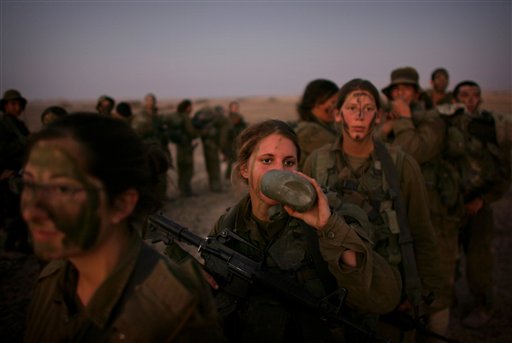I have been troubled by this photograph since it appeared recently:
The photograph was taken December 20, 2006, during the final stages of a training march in southern Israel. It was circulated the week of September 17, 2007 to accompany stories about a commission report recommending that Israel’s military should allow women into front-line combat positions, including special forces.
This topic is a minefield, and I doubt I can say anything without offending some readers. The question of policy activates commitments to gender equality and the defense of Israel, as well as criticism of Israel’s security strategy and of militarism more generally. Equally important, each of these issues carries arguments about who has more or less authority to speak at all on the matter.
I have typically progressive positions on these issues, but I doubt that alone explains why I was stopped short by the photograph. I don’t just see the image alone, but two others that lie beneath it like a palimpsest. It draws its rhetorical power from one of these images, while the other raises a horrific specter that should be stated in the hope of critical reflection.
The first image to which the photo alludes is the typical shot of military troops, often special forces, deploying in full combat gear including the camouflage face paint applied for battle. We see these images in newspaper photographs, recruiting ads (Army Rangers, Navy Seals), movies and movie posters, and video games. In like manner, the woman in the front of the frame and the tall woman in the middle both are streaked with the black paint. That, along with the canteen and the caption push the viewer to see the women as combat troops in the making: trained, tough, and ready to go. If you look at the second and third women, they almost already have the thousand yard stare.
And maybe that’s what reminded me of the second image that lies latent within the photo: the image of Jewish women standing in line in a concentration camp. There actually are a number of such images; you can see one set here at the Yad Vashem web site. Look again at the photo above. Maybe you see only the gear and strong women. I see that and I also see Jewish women standing in a line, captives of the national security state.
What makes judgment so difficult in this case is that both images can be true at the same time. Israeli women are and will be everything one could ask of a special forces commando. And these women could be killed because of self-destructive state policies that are the issue not only of concerns about security but also of militarism and paranoia.
I have to add that all this is still far better than anything Hamas would do. Israel is not the reason the IDF needs women on the front lines. Israel is not where we need to worry about women being confined and denied basic civil and human rights. And as my friends who are hawks love to remind me, Israel is a vibrant democracy. This last point is exactly why I have to say what I saw in the photograph. There is reason to speak because Israel is a democracy and therefore open to public opinion, not to mention the financial, military, and political support that is provided by the US government and thus the legitimate concern of every US citizen. Perhaps I’m mad to be haunted by the image, but I believe that at times Israel, like the US, like many powerful states historically, can be dangerous to others and to its own people. Should the women in the photograph have to die in the defense of Israel, I see no basis for criticism of the report’s policy recommendation. But that defense may not be necessary, or, most important, may be more likely to occur precisely because of state policies that rely too much on military superiority and the normalization of war. Perhaps the question of Israel’s defense has nothing to do with my reaction to a photograph. It may be, however, that a photo shows more than we would like to admit about how people can become enslaved by force, even when it is of their own making.
Photograph by Oded Balilty/Associated Press.

Discussion